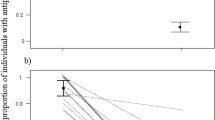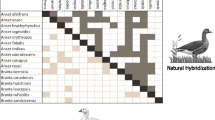Abstract
Predation is one of the most selective forces in evolution and, thus, predation may select against hybrids in narrow hybrid zones. It may be possible that parental phenotypes and hybrids differ in their responses towards predators or humans. As predation is difficult to observe I used flight-initiation distance (FID) as a metric of risk assessment. FID is a measurable outcome of the trade-off between fleeing and remaining. Here, I tested whether hybrid and parent crow phenotypes (Corvus corone, Corvus cornix) from the hybrid zone in Eastern Germany differ in their FID. Further, I measured many environmental and social variables to control statistically for their influence on FID. I sampled 154 individuals (53 hooded crows, 54 carrion crows, and 48 hybrids) in the hybrid zone in eastern Germany. I calculated a general linear model using a stepwise backward procedure to establish a minimum model containing only significant variables that explained FID in crows. The variable phenotype (hooded, carrion, hybrid) was then added to the model. There were no differences in FID between hybrids and both parental phenotypes types, suggesting similar risk assessment. This suggests that hybrids may behave similarly in their decision to flee as their parent phenotypes, which, in turn, provides no evidence for a selective disadvantage. An additional analysis focusing on pure phenotypic flocks showed that hybrids in pure hybrid flocks had a lower FID than both parental species in pure flocks. This suggests that hybrids in pure hybrid flocks may be at a disadvantage.

Similar content being viewed by others
References
Anholt BR, Negovetic S, Rauter C, Som C (2005) Predator complement determines the relative success of tadpoles of the Rana esculenta complex. Evol Ecol Res 7:733–741
Barton NH, Hewitt GM (1985) Analysis of hybrid zones. Ann Rev Ecol Syst 16:113–148
Barton NH, Hewitt GM (1989) Adaption, speciation and hybrid zones. Nature 341:497–503
Beale CM, Monaghan P (2004) Behavioural response to human disturbance: a matter of choice? Anim Behav 68:1065–1069
Blumstein DT (2003) Flight-initiation distance in birds is dependent on intruder starting distance. J Wildl Manage 67:852–857
Blumstein DT, Anthony LL, Harcourt A, Ross G (2003) Testing a key assumption of wildlife buffer zones: is flight-initiation distance a species-specific trait? Biol Conserv 110:97–100
Blumstein DT, Fernandez-Juricic E, Zollner PA, Garity SC (2005) Inter-specific variation in avian responses to human disturbances. J Appl Ecol 42:943–953
Boland CRJ (2003) An experimental test of predator detection rates using groups of free-living emus. Ethology 109:209–222
Boyer JS, Hass LL, Lurie MH, Blumstein DT (2006) Effect of visibility on time allocation and escape decisions in crimson rosellas. Aust J Zool 54:363–367
Brodin A, Haas F (2006) Speciation by perception. Anim Behav 72:139–146
Bronson CL, Grubb TC, Sattler GD, Braun MJ (2003) Mate preference: a possible causal mechanism for a moving hybrid zone. Anim Behav 65:489–500
Bronson CL, Grubb TC, Sattler GD, Braun MJ (2005) Reproductive success across the black-capped chickadee (Poecile atricapillus) and carolina chickadee (P. carolinensis) hybrid zone in Ohio. Auk 122:759–772
Burger J, Gochfeld M (1991) Human activity influence and diurnal and nocturnal foraging of sanderlings (Calidris alba). Condor 93:259–265
Caro T (2005) Anti-predator defence in mammals and birds. Chicago University Press, Chicago
Cooke AS (1980) Observations on how close certain passerine species will tolerate an approaching human in rural and suburban habitats. Biol Conserv 18:85–88
Cresswell W (1994) Flocking is an effective anti-predation strategy in redshanks, Tringa totanus. Anim Behav 47:433–442
Cresswell W, Quinn JL (2004) Faced with a choice, sparrowhawks more often attack the more vulnerable prey. Oikos 104:71–76
Den Hartog PM, de Kort SR, ten Cate C (2007) Hybrid vocalizations are effective within, but not outside an avian hybrid zone. Behav Ecol 18:608–614
Fernández-Juricic E, Schroeder N (2003) Do variations in scanning behavior affect tolerance to human disturbances? Appl Anim Behav Sci 84:219–234
Fernández-Juricic E, Vaca R, Schroeder N (2004) Spatial and temporal responses of forest birds to human approaches in a protected area and implications for two management strategies. Biol Conserv 117:407–416
Fernández-Juricic E, Venier MP, Renison D, Blumstein DT (2005) Sensitivity of wildlife to spatial patterns of recreationist behavior. A critical assessment of minimum approaching distances and buffer areas for grassland birds. Biol Conserv 125:225–235
Frid A, Dill LM (2002) Human-caused disturbance stimuli as a form of predation risk. Cons Ecol 6(1):11. http://www.consecol.org/vol6/iss1/art11
Good TP, Ellis JC, Annett CA, Pierotti R (2000) Bounded hybrid superiority in an avian hybrid zone: effects of mate choice, diet, and habitat choice. Evolution 54:1774–1783
Götmark F (1999) The importance of non-reproductive functions of bird coloration, especially anti-predator adaptions. In: Proceedings of 22nd international ornithological congress, pp 1706–1718
Götmark F, Hohlfält A (1995) Bright male plumage and predation risk in passerine birds: are males easier to detect than females? Oikos 74:475–484
Garamszegi LZ, Moller AP, Erritzoe J (2002) Coevolving eye size and brain size in relation to prey capture and nocturnality. Proc R Soc Lond B 269:961–967
Grant PR, Grant BR (1992) Hybridization of bird species. Science 256:193–197
Gunzburger MS (2005) Differential predation on tadpoles influences the potential effects of hybridization between Hyla cinerea and Hyla gratiosa. J Herpetol 39:682–687
Haas F, Brodin A (2005) The crow hybrid zone in southern Denmark and northern Germany. Ibis 147:649–656
Kennedy SP, Knight SL (1992) Flight distances of black-billed magpies in different regimes of human density and persecution. Condor 94:545–547
Meise W (1928) Die Verbreitung der Aaskrähe (Formenkreis Corvus corone L.). J Ornithol 76:1–204
Parkin DT, Collinson M, Helbig AJ, Knox AG, Sangster G (2003) The taxonomic status of carrion and hooded crows. Br Birds 96:274–290
Parris MJ, Laird CW, Semlitsch RD (2001) Differential predation on experimental populations of parental and hybrid leopard frog (Rana blairi and Rana sphenocephala) larvae. J Herpetol 35:479–485
Pearson SF (2000) Behavioral asymmetries in a moving hybrid zone. Behav Ecol 11:84–92
Quinn JL, Cresswell W (2005) Escape response delays in wintering redshank, Tringa totanus, flocks: perceptual limits and economic decisions. Anim Behav 69:1285–1292
Randler C (2002) Hybridization, mixed pairing and female choice. Anim Behav 63:103–119
Randler C (2003) Vigilance in urban Swan Geese and their hybrids. Waterbirds 26:257–260
Randler C (2004) Aggressive interactions in Swan Geese Anser cygnoides and their hybrids. Acta Ornithol 39:147–153
Randler C (2004) Frequency of bird hybrids: does detectability make all the difference? J Ornithol 145:123–128
Randler C (2006) Behavioural and ecological correlates of natural hybridization in birds. Ibis 148:459–467
Randler C (2007) Assortative mating of carrion Corvus corone and hooded crows C. cornix in the hybrid zone in eastern Germany. Ardea 95:143–149
Richardson CT, Miller CK (1997) Recommendations for protecting raptors from human disturbances: a review. Wildl Soc Bull 25:634–638
Roberts G (1997) How many birds does it take to put a flock to flight? Anim Behav 54:1517–1522
Rolando A (1993) A study on the hybridization between carrion and hooded crow in Northwestern Italy. Ornis Scand 24:80–83
Rolando A, Laiolo P (1994) Habitat selection of hooded and carrion crows in the alpine hybrid zone. Ardea 82:193–200
Rolando A, Caldoni R, de Sanctis A, Laiolo P (2001) Vigilance and neighbour distance in foraging flocks of red-billed choughs, Pyrrhocorax pyrrhocorax. J Zool 253:225–232
Ruxton GD, Sherrat TN, Speed MP (2004) Avoiding attack. Oxford University Press, Oxford
Saino N, Scatizzi L (1991) Selective aggressiveness and dominance among carrion crows, hooded crows and hybrids. Boll Zool 58:255–260
Saino N, Villa S (1992) Pair composition and reproductive success cross a hybrid zone of carrion and hooded crows. Auk 109:543–555
Semlitsch RD (1993) The effects of different predators on the survival and development of tadpoles of the hybridogenetic Rana esculenta complex. Oikos 67:40–46
Spaak P, Hoekstra JR (1997) Fish predation on Daphnia hybrid species complex: a factor explaining species coexistence. Limnol Oceanogr 42:753–762
Stankowich T, Blumstein DT (2005) Fear in animals: a meta-analysis and review of risk assessment. Proc R Soc B. doi:10.1098/rspb.2005.3251
Stillman RA, Goss-Custard JD (2002) Seasonal changes in the response of oystercatchers Haematopus ostralegus to human disturbances. J Avian Biol 33:358–365
Vamosi SM, Schluter D (2002) Impacts of trout predation on fitness of sympatric sticklebacks and their hybrids. Proc R Soc Lond B 269:923–930
Vamosi SM, Hatfield T, Schluter D (2000) A test of ecological selection against young-of-the-year hybrids of sympatric sticklebacks. J Fish Biol 57:109–121
Webb NV, Blumstein DT (2005) Variation in human disturbance differentially affects predation risk assessment in western gulls. Condor 107:178–181
Yasué M (2006) Environmental factors and spatial scales influence shorebirds’ responses to human disturbance. Biol Conserv. doi:10.1016/j.biocon.2005.09.015
Ydenberg RC, Dill LM (1986) The economics of fleeing from predators. Adv Study Behav 16:229–249
Acknowledgments
The study complies with current law in Germany and was partly funded by the University of Leipzig. I am grateful to two anonymous referees for improving the English and for clarifying some thoughts.
Author information
Authors and Affiliations
Corresponding author
About this article
Cite this article
Randler, C. Risk assessment by crow phenotypes in a hybrid zone. J Ethol 26, 309–316 (2008). https://doi.org/10.1007/s10164-007-0062-z
Received:
Accepted:
Published:
Issue Date:
DOI: https://doi.org/10.1007/s10164-007-0062-z




